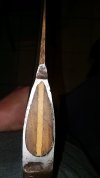I wanted to bring up another fad right now (and probably one that will last the age of time I feel).. that is using exotic hardwoods to wedge for aesthetic reasons.
It seems that the general consensus on this forum is that using wood which is softer then the handle is the way to go. Softwood will compress and fill the gaps in the grain and bined together with the harder wood more harmoniously. Makes perfect sense!
I was looking through a post on a facebook axe page where someone asked what type of wood you should use to wedge and shockingly very few people mentioned this. I mean less then 20% held this opinion. I don't know if people are more interested in an axe looking cool opposed to working well or perhaps it is ignorance.
Flicking through the collection of photos it seems people are using all sorts of hardwoods, especially bloodwood being very popular right now which comes in on the janka scale 2,900 lbf (12,900 N), absolutely blowing Hickory out of the water.
I am curious if the ratio stays the same (but the component flipped obviously) will it create a similar effect? Say something like the Walnut hardness to Hickory hardness being similar ratio to the hardness of Hickory to bloodwood. Perhaps they will mate in a similar fashion?
Also, In regards to advice I have seen before along the lines of "If it's an old head I would be careful using hardwood wedges because you will likely blow out the sides." Can someone explain what blow out looks like, even better does anyone have a picture of what it looks like? If this happens is the axe still functional or is it gone? Are we talking cracking the eye or stretching the steel a little?
It seems that the general consensus on this forum is that using wood which is softer then the handle is the way to go. Softwood will compress and fill the gaps in the grain and bined together with the harder wood more harmoniously. Makes perfect sense!
I was looking through a post on a facebook axe page where someone asked what type of wood you should use to wedge and shockingly very few people mentioned this. I mean less then 20% held this opinion. I don't know if people are more interested in an axe looking cool opposed to working well or perhaps it is ignorance.
Flicking through the collection of photos it seems people are using all sorts of hardwoods, especially bloodwood being very popular right now which comes in on the janka scale 2,900 lbf (12,900 N), absolutely blowing Hickory out of the water.
I am curious if the ratio stays the same (but the component flipped obviously) will it create a similar effect? Say something like the Walnut hardness to Hickory hardness being similar ratio to the hardness of Hickory to bloodwood. Perhaps they will mate in a similar fashion?
Also, In regards to advice I have seen before along the lines of "If it's an old head I would be careful using hardwood wedges because you will likely blow out the sides." Can someone explain what blow out looks like, even better does anyone have a picture of what it looks like? If this happens is the axe still functional or is it gone? Are we talking cracking the eye or stretching the steel a little?

 plumb_jersey_crack
plumb_jersey_crack plumb_jersey_hung
plumb_jersey_hung


